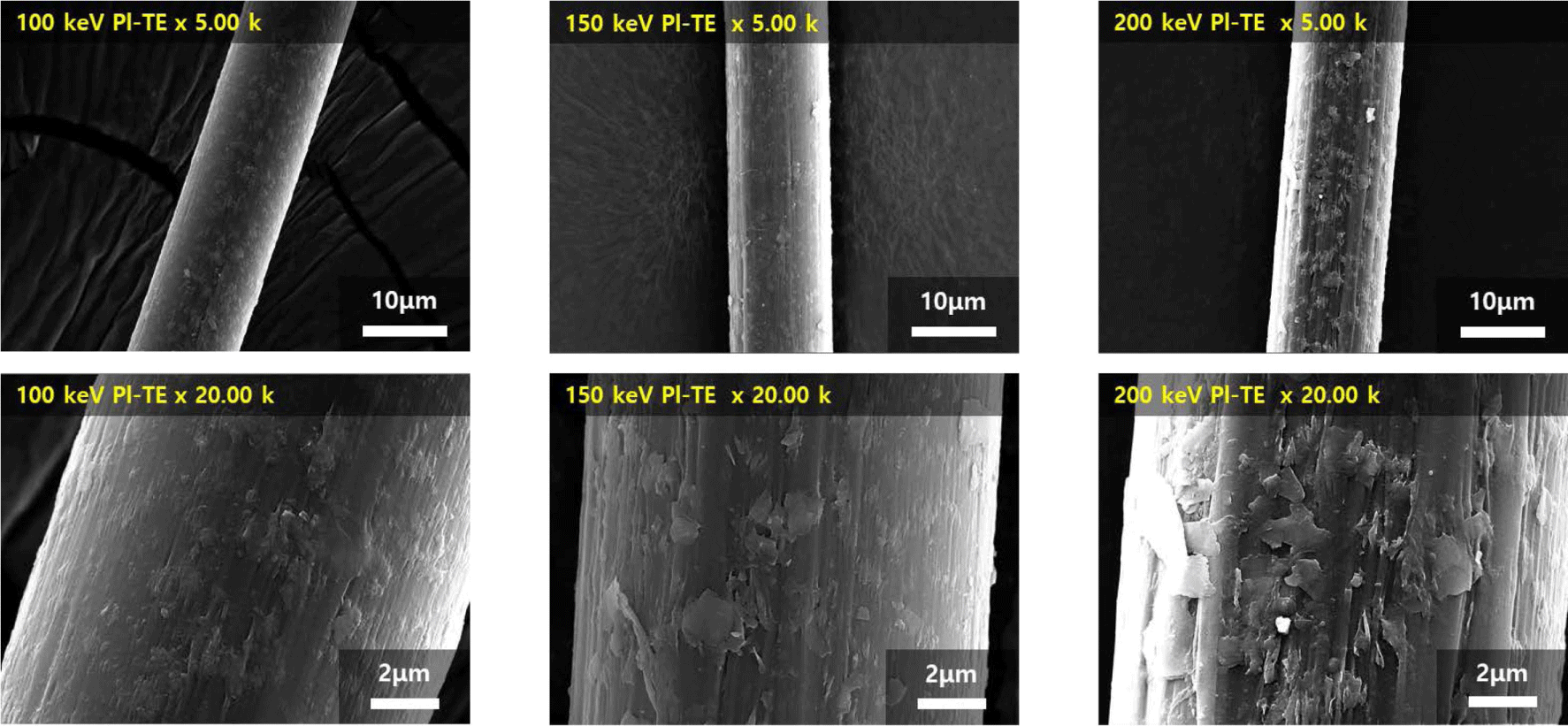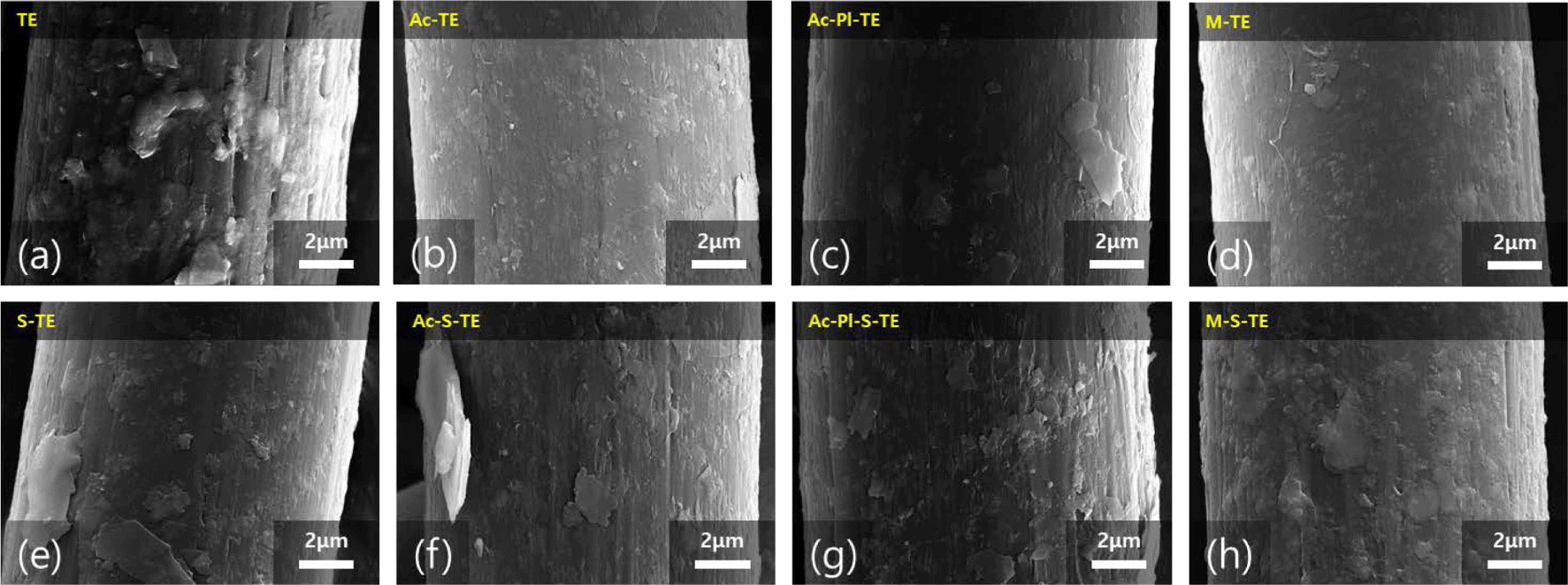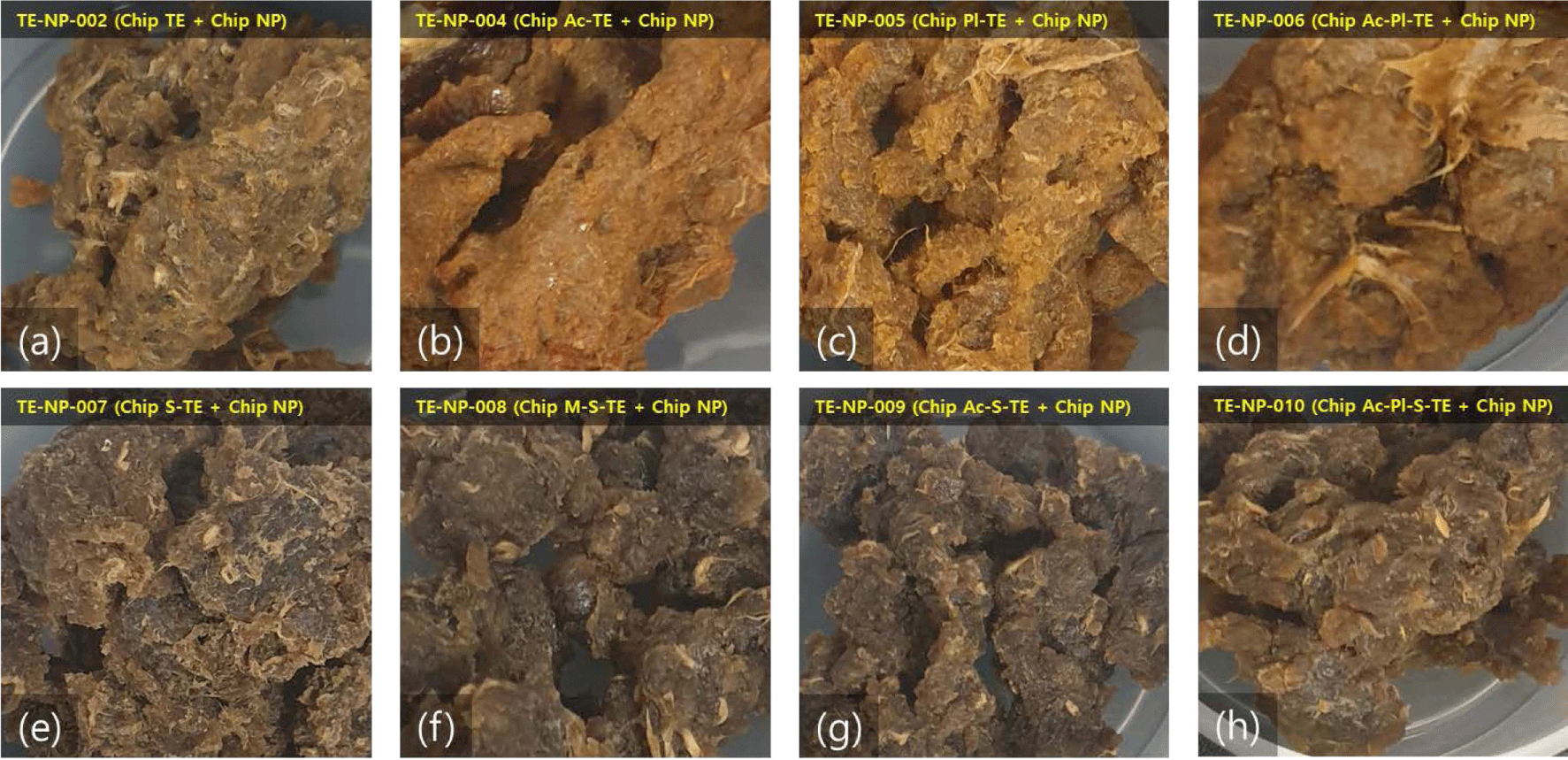Article
Investigation of Co-poly-para-aramid Fiber Dispersion in Chloroprene Rubber Matrix and Improvement of Dispersibility Through Fiber Surface Modification
Garam Park*, Hyeri Kim*, Gayeon Jeong**, Dohyeong Kim***, Seungchan Noh***, Dajeong Gwon**, Myung Chan Choi****, Jaseung Koo**,†
*Research Institute for Applied chemistry and Biological Engineering, Chungnam National University, No236, W3, 99 Daehak-ro(St), Yuseonggu, Daejeon 34134, Republic of Korea
**Department of Organic Materials Engineering, Chungnam National University, No236, W3, 99 Daehak-ro(St), Yuseonggu, Daejeon 34134, Republic of Korea
***Department of Organic Applied Materials Engineering, Chungnam National University, No236, W3, 99 Daehak-ro(St), Yuseonggu, Daejeon 34134, Republic of Korea
****Rubber Research Division, Korea Institute of Footwear & Leather Technology
© Copyright 2022 The Rubber Society of Korea. This is an Open-Access article distributed under the terms of the
Creative Commons Attribution Non-Commercial License (http://creativecommons.org/licenses/by-nc/4.0/) which permits
unrestricted non-commercial use, distribution, and reproduction in any
medium, provided the original work is properly cited.
Received: Oct 25, 2022; Revised: Nov 17, 2022; Revised: Dec 11, 2022; Accepted: Dec 12, 2022
Published Online: Dec 31, 2022
Abstract
To produce a co-poly-para-aramid fiber (AF, Technora®)-reinforced neoprene rubber composite, dispersion of AF in a neoprene matrix is investigated. The AF is then surface-modified by mercerization and acetone, plasma, and silane treatments to improve dispersibility. Finally, an internal mixer process is used to disperse the surface-modified fibers in the neoprene rubber matrix.
Keywords: surface-modification; aramid fiber; chloroprene rubber; fiber-rubber composite; dispersibility; surface adhesion
Introduction
복합재료는 두가지 재료를 섞어 한 물질로는 발현될 수 없는 특성을 가진 소재이다. 대부분은 두 가지 상으로 이루어져 있고, 매트릭스(matrix)와 분산상(dispersed phase)으로 구분되는 계면을 가진다.1 분산상은 매트릭스의 특성을 강화시키기 위한 역할이며, 그 중에서도 섬유는 저강도/저내열성인 플라스틱 매트릭스의 보강재로서 널리 사용되고 있다. 섬유 강화 복합재료에 사용되는 섬유로는 유리섬유, 탄소 섬유, 아라미드 섬유, 실리콘 카바이드 섬유 등이 있다. 특히, 아라미드 섬유는 고강도, 내열성, 내화학성 및 고탄성의 특성이 우수하여 주목받고 있다. 아라미드 섬유는 고강도 소재로서 개발된 섬유2-4로 대표적으로 파라아라미드(para-armid) 계열인 케블라(poly-paraphenylene terephthalamide, Kevlar®)와 공중합파라아라미드 계열인 테크노라(co-poly-(paraphenylene/3,4'-oxydiphenylene terephthalamide), Technora®, TE) 섬유가 있다. 파라계 아라미드 섬유중 가장 강도가 뛰어난 테크노라 섬유는 동일한 중량 기준 강철의 8배의 강도를 가지며 모듈러스가 높고, 500°C 근처에서 분해되어 내열성이 뛰어나고, 화학적 비활성 특성으로 내화학성 등이 좋아 고강도/고성능 섬유로서 주목받고 있다.
네오프렌 고무(CR, Neoprene, polycycloprene)는 합성고무로 뛰어난 보온성과 열에 강해 전선 피복, 호스, 접착제 등으로 사용되며 특히 잠수복 제작에 많이 사용된다.5 또한 내화학성과 넓은 온도범위에서 유연성을 유지하는 특징이 있어 공업용 장갑, 장화, 글로브 박스 고무 장갑 등, 다양한 상공업 제품에 사용되고 있다.
고무는 장기간 사용시 마모되는 단점이 있어 내마모성을 증가시키는 것이 관건이다. 특히 타이어분야에서는 내마모성뿐만 아니라 연료절감 효율도 증가시키기 위해 섬유-강화 고무 복합재 연구가 많이 이뤄지고 있다. 아라미드 섬유는 마찰감소 특성을 가지고 있어 고무 혼합물의 마모를 감소시키는 것으로 알려져있다.6 씰링 복합 재료로 많이 사용되는 석면 복합재는 에너지 및 환경 문제로 이를 대체하기 위한 대안 재료로서 아라미드 섬유 강화 복합재가 관심을 받고있다.7 이런 이유로 아라미드 섬유 강화 고무 복합재 제작에 많은 연구가 진행되고 있다. 하지만 아라미드 섬유는 화학적 불활성 및 매끄러운 표면 특성으로 인해 매트릭스와의 접착력이 약하고,8-10 섬유간 응집이 좋아 매트릭스 내 분산성이 좋지 않다. 따라서 아라미드 섬유-매트릭스 표면 접착력 및 분산성을 개선하기 위하여 열처리, 코팅11, 표면개질, 나노스케일화 등이 활발히 연구되고 있다.
아라미드 섬유의 표면개질은 궁긍적으로 섬유의 표면 화학 활성을 개선하고 표면 거칠기를 증가시켜 섬유-매트릭스 계면의 우수한 화학적 결합 및 기계적 연동을 개선하는 것이다. 대표적인 파라 아마이드 섬유인 케블라(Kevlar®)는 표면개질을 통한 분산성 및 계면 결합성 개선을 위해 산-염기처리,12-18 커플링제,19,20 플라즈마,21-28 γ-선 처리,29-31 코팅32-36 등의 연구가 진행되어있다. 하지만 공중합 파라 아라미드인 테크노라의 표면개질 연구는 거의 연구되어 있지 않다.
본 연구에서는 네오프렌 매트릭스 내 테크노라 섬유의 분산성에 대해 조사하였다. 테크노라 섬유를 네오프렌 매트릭스에 분산시키기 위해 섬유를 아세톤(Acetone) 처리, 플라즈마(Plasma) 처리, 머서화(Mercerization), 실란(Silane) 처리로 표면개질하여 밀폐식 혼합기(Internal mixer)에서 혼련하여 섬유의 표면개질이 네오프렌 매트릭스내 분산에 미치는 영향에 대해 고찰하였다.
Experimental
1. 시약 및 재료
본 실험에 사용한 아라미드 섬유 중 하나인 테크노라(Technora®)는 TEIJIN 사에서 구입하여 사용하였다. 테크노라의 정보는 Table 1에 나타내었다. 클로로프렌 고무(Chloroprene®, S-40V)는 Denka사로부터 구입하여 사용하였다. 아세톤 처리에 사용된 아세톤은 SAMCHUN chemical에서 구입하여 사용하였다. 머서화에 사용된 수산화 칼륨(Potassium hydroxide, KOH)는 Fishier chemical에서 구입하여 사용하였다. 표면개질용 실란 커플링제는 Merck (Sigma-Aldrich)사의 vinylethoxy silane (VES)을 구입하여 사용하였다.
Table 1.
Information of the Technora® Fiber.
|
|
Unit |
Technora®
|
|
Density |
g/cm3
|
1.39 |
|
Tensile strength |
GPa |
3.2 ~ 3.5 |
|
Tenacity |
N/tex |
2.3 ~ 2.5 |
|
Modulus |
GPa |
65 ~ 85 |
|
Elongation at break |
% |
3.9 ~ 4.5 |
|
Moisture |
% |
1.9 |
|
Decomposition or melting temperature |
°C
°F |
500
932 |
|
Limiting Oxygen Index(LOI) |
% |
25 ~ 40 |
Download Excel Table
2. 특성분석
복합재의 모폴로지 측정은 주사전자현미경(Scanning electronic microscope : SEM, TESCAN사의 CLARA)를 사용하였다. 시편은 2 mm × 2 mm × 1 mm 사이즈로 잘라 매끈한 면을 sputter current 20 mA, sputter time 60s 조건에서 백금(Pt)으로 0.04 nm 두께로 코팅하여 SEM 측정에 사용하였다.
3. 테크노라(TE) 섬유 전처리
실험에 사용된 모든 테크노라 섬유는 5 mm 이하로 잘라 준비하였다. 테크노라 섬유의 아세톤 처리는 섬유를 아세톤 용매에 넣고 50분간 초음파기(sonication)를 이용하여 처리하여 하루동안 공기중에 건조시켜 준비하였다. 테크노라 섬유의 플라즈마 처리37는 섬유를 플라즈마 처리 장치에 넣어, 15분간 처리하여 준비하였다. 플라즈마 처리 전력은 200W이며 150 sccm 유입속도의 O2 가스를 사용하였다. 테크노라 섬유의 머서화38는 섬유를 5% KOH 용액에 30분동안 침지시킨 후, 남은 KOH 용액을 제거하기 위하여 2% HCl 용액 100 mL로 3번 세척하고 하루동안 공기중에 건조하여 준비하였다. 테크노라 섬유의 실란 처리38를 위해 실란 커플링제로 Vinyltrieth-oxysilane (VES)을 사용하였다. 섬유를 6% VES 용액 100 mL (ethanol:H2O=6:4)에 90분간 침지시킨 후, 섬유는 에탄올-증류수 혼합용매(ethanol:H2O=6:4)로 세척하여 공기중에서 90분간 건조하고, 하루동안 공기중에 건조하여 준비하였다.
4. 테크노라 섬유 강화 네오프렌 복합재 제조
테크노라-네오프렌 복합재 제조 조건은 Table 2에 나타내었다. 다양한 표면개질 효과를 보기 위하여 아세톤 처리(Ac), 플라즈마 처리(Pl), 실란 처리(S), 머서화(M)를 선택하여 조합하였다.
Table 2.
Surface Treatment Condition of the Technora® Fiber.
|
#Sample |
Treated Technora®
|
Acetone treatment |
Silane treatment |
Mercerization |
Plasma treatment |
|
TE-NP-002 |
TE |
- |
- |
- |
- |
|
TE-NP-004 |
Ac-TE |
O |
- |
- |
- |
|
TE-NP-005 |
Pl-TE |
- |
- |
- |
O |
|
TE-NP-006 |
Ac-Pl-TE |
O |
- |
- |
O |
|
TE-NP-007 |
S-TE |
- |
O |
- |
- |
|
TE-NP-008 |
M-S-TE |
- |
O |
O |
- |
|
TE-NP-009 |
Ac-S-TE |
O |
O |
- |
- |
|
TE-NP-010 |
Ac-Pl-S-TE |
O |
O |
- |
O |
Download Excel Table
Table 2을 바탕으로 밀폐형 혼합기를 이용하여 컴파운드를 제조하였다. 제조 공정은 Scheme 1에 나타내었다. 밀폐형 혼합기 사용 시, Fill factor는 혼합기 용량의 약 70%로 설정하였으며, 섬유-매트릭스 배합량은 2 wt.% 비율로 총량 50g으로 설정하였다. 5 mm 이하로 자른 네오프렌 고무를 준비하여 140°C에서 50 sec 동안 용융 혼련해 준 후, 테크노라 단섬유를 조금씩 천천히 넣어주었다. 섬유가 모두 투여된 후, 140°C에서 30 rpm으로 300 sec 동안 혼련하여 복합재를 제조하였다.
Results and Discussion
플라즈마의 처리전력에 따른 섬유의 특성을 분석하기 위하여, 아세톤 처리 후, 각각 100, 150, 200 keV의 처리전력으로 처리한 섬유의 SEM 이미지를 Figure 1에 나타내었다. Figure 1에서 처리전력이 증가할수록 표면 거칠기가 증가하는 경향성이 관찰된다. 플라즈마 처리를 통한 섬유 표면 에칭으로 인해 섬유 다발이 표면에서 관찰되고, 섬유 표면이 나무껍질처럼 점점 박리되는 모습이 관찰되었다. 따라서 처리전력에 따라 증가된 표면 거칠기는 섬유의 표면적 증가와 매트릭스와의 접착성능을 개선할 것으로 기대된다. Figure 1의 결과를 바탕으로 섬유-매트릭스 접착을 위한 테크노라 섬유의 효율적인 플라즈마 전력은 200W로 결정하여 플라즈마 실험을 진행하였다.
Figure 2에 표면개질된 테크노라 섬유의 SEM 이미지를 나타내었다. 처리하지 않은 기본 테크노라 섬유(a)는 표면에 유제가 불순물로 묻어 있는 것을 확인할 수 있다. 아세톤 처리한 테크노라 섬유(b)는 유제가 씻겨져 깔끔한 표면을 가진 것을 확인할 수 있으며, 아세톤 처리된 섬유들(b, c, f, g)는 전체적으로 좀더 깔끔한 표면을 가진 것을 확인할 수 있다. 아세톤 처리 후 플라즈마 처리한 섬유(c)는 에칭되어 섬유가 얇게 껍질로 벗겨져 박피된것을 확인할 수있다. 머서화 처리한 섬유(d)는 섬유표면의 다발이 생성되기 시작한 것을 관찰할 수 있었다. 또한 실란 처리(e, f, g, h)한 섬유들은 전체적으로 섬유 박피 현상이 관찰되었다.
Figure 3에 제조된 테크노라-네오프렌 복합재 시료를 나타내었다. Bulk 시료는 육안 상, (b)아세톤 처리, (e)실란 처리, (g)아세톤-실란-처리 및 (h)아세톤-플라즈마-실란 처리 복합재가 가장 잘 분산된 것으로 관찰되었다. 특히 (e)실란 처리 섬유는 가장 좋은 분산성을 가진것으로 판단되며, 실란 처리된 시료(e, f, g, h)가 실란 처리 전 시료(a, b, c, d)보다 분산성이 전체적으로 개선된 것이 관찰되었다. 이는 실란 처리 후, 섬유간 뭉침 현상이 감소하였기 때문으로 판단된다.
Figure 4는 표면개질된 테크노라-네오프렌 복합재를 섬유가 가장 잘 분산되어 보이는 부분을 선정하여 가위로 잘라 단면을 관찰한 SEM 이미지이다(Ac : 아세톤 처리, Pl : 플라즈마 처리, S : 실란 처리, M : 머서화). 전체적으로 섬유가닥들이 분산되어 있고, 섬유를 네오프렌 매트릭스가 감싸고 있는 것을 확인할 수 있었다.
Figure 4.
SEM micrographs of neoprene composites reinforced with 2 wt.% of treated TE-NP composite.
Download Original Figure
본 연구에서는 테크노라-네오프렌 복합재 제작을 위한 기초연구로 섬유의 분산성을 확인하였고 이를 위해 섬유 2 wt.%의 복합재를 제작하였다. 본 연구를 기반으로, 후속적으로 복합재의 물리적/기계적 특성(인장강도 등)에 영향을 주는 섬유-매트릭스간 계면 접착성에 대해 연구하고자 하며, 이를 위하여 표면개질된 섬유의 당량별 시료를 제작하고자 한다.
Conclusions
테크노라-네오프렌 복합재를 제조하기위한 섬유의 분산성 실험에서 (e)실란 처리된 테크노라 섬유가 분산 성능이 가장 뛰어난 것을 확인하였고, 실란 처리된 시료(e, f, g, h)는 머서화(f)를 제외하고 전체적으로 분산성이 좋아지는 것을 확인하였다. 이번 실험 결과는 많은 공중합아라미드 섬유 중 특히 테크노라 섬유의 매트릭스 분산 분야에서 좋은 예시로써 활용될 수 있을 것으로 예상된다.
Acknowledgements
This work was supported by the Textile composite structure virtual engineering platform construction (Grant number P0022335). This work was supported by the Ministry of Science and ICT (MSIT, Korea) development of ultra-high performance aramid copolymer fiber and design of non-woven intermediate for composite applications (Grant number 2021M3H4A3A01043764).
References
P. K. Mallick, “Fiber Reinforced Composites. Materials, Manufacturing and Design”, Marcel Dekker, New York (1997).

D. Han, Q. Ma, J. Wang, H. Chen, C. Wang, and W. Han, “Effect of the Addition of Different Amounts of Aramid Fibers on Metal Friction and Wear during Mixing”,
Polymers,
14, 2961 (2022).




T. S. Lee, B. S. Kim, H. N. Choi, K. Y. Lee, and S. G. Lee, “Interfacial Adhesion Properties of Plasma Treated Aramid Fiber with Chloroprene Rubber”,
Textile Science and Engineering,
47, 3 (2010).

P. A. Sreekumar, S. P. Thomas, J. M. Saiter, K. Joseph, G. Unnikrishnan, and S. Thomas, “Effect of fiber surface modification on the mechanical and water absorption characteristics of sisal/polyester composites fabricated by resin transfer molding”,
Composites Part A: Applied Science and Manufacturing,
40, 11, 1777 (2009).


Y. Kwon, S. Jun, J. Han, and D. Lee, “Gasket life criteria at low temperatures adopting proportional compensation for loss of flexibility and conformability”,
International Journal of Automotive Technology,19, 99 (2018).


Y. Kwon, S. Jun, and J. Song, “Lifetime analysis of rubber gasket composed of methyl vinyl silicone rubber with low-temperature resistance”,
Mathematical Problems in Engineering,
2015, 1, (2015).


L. Chen and B. Gu, “Predicting fatigue damage in interphase of short fiber reinforced rubber composites under transverse load”,
Polymer Composites,
39, 1455 (2018).


P. Li, H.Y. Duan, Y. F. Liu, and Q. G. Huang, “Multi-walled carbon nanotubes as secondary fibre fillers for property improvement of short carbon fibre-reinforced silicone rubber”,
Bulletin of Materials Science,
42, 177 (2019).


P. Pittayavinai, S. Thanawan, and T. Amornsakchai, “Comparative study of natural rubber and acrylonitrile rubber reinforced with aligned short aramid fiber”,
Polymer Testing,
64, 109 (2017).


C. Franco, U. Ornella, L. Edo, and A. Giancarlo, “A comparative study on the reinforcing effect of aramide and PET short fibers in a natural rubber-based composite”,
Journal of Macromolecular Science, Part B,
48,6, 1241 (2009).


M. A. López, Manchado, and M. Arroyo, “Short fibers as reinforcement of rubber compounds”,
Polymer Composites,
23, 4, 666 (2002).


X. Chen, W. Wang, and C. Jiao, “A recycled environmental friendly flame retardant by modifying para-aramid fiber with phosphorus acid for thermoplastic polyurethane elastomer”,
Journal of Hazardous Materials,
331, 257 (2017).



J. Zhao, “Effect of surface treatment on the structure and properties of para-aramid fibers by phosphoric acid”,
Fibers and Polymers,
14, 59 (2013).


K. Wu, X. Wang, Y. Xu, and W. Guo, “Flame retardant efficiency of modified paraaramid fiber synergizing with ammonium polyphosphate on PP/EPDM”,
Polymer Degradation and Stability,
172, 109065 (2020).


H. Zhang, G. Liang, A. Gu, and L. Yuan, “Facile preparation of hyperbranched polysiloxane-grafted aramid fibers with simultaneously improved UV resistance, surface activity, and thermal and mechanical properties”,
Industrial & Engineering Chemistry Research,
53, 2684 (2014).


S. He, G. Sun, X. Cheng, H. Dai, X. Chen, “Nanoporous SiO
2 grafted aramid fibers with low thermal conductivity”,
Composites Science and Technology,
146, 91 (2017).


K. Haijuan, S. Hui, C. Jin, D. Haiquan, D. Xiaoma, Q. Mengmeng, Y. Muhuo, and Z. Youfeng, “Improvement of adhesion of kevlar fabrics to epoxy by surface modification with acetic anhydride in supercritical carbon dioxide”,
Polymer Composites,
40, E920 (2019).


L. Yin, Z. Zhou, Z. Luo, J. Zhong, P. Li, B. Yang, and L. Yang, “Reinforcing effect of aramid fibers on fatigue behavior of SBR/aramid fiber composites”,
Polymer Testing,
80, 106092 (2019).


H. Wang, J. Wu, C. Cai, J. Guo, H. Fan, C. Zhu, H. Dong, N. Zhao, and J. Xu, “Mussel inspired modification of polypropylene separators by catechol/polyamine for Li-ion batteries”,
ACS Applied Materials & Interfaces,
6, 5602 (2014) .



S. Zhang, Z. Shi, P. Cui, N. Duan, and X. Li, “Surface modification of aramid fibers with CaCl
2 treatment and secondary functionalization of silane coupling agents”,
Applied Polymer Science,
15, 49159 (2020).


H. Yuan, W. Wang, D. Yang, X. Zhou, Z. Zhao, L. Zhang, S. Wang, and J. Feng, “Hydrophilicity modification of aramid fiber using a linear shape plasma excited by nanosecond pulse”,
Surface and Coatings Technology,
344, 614, (2018).


C. Jia, P. Chen, W. Liu, B. Li, and Q. Wang, “Surface treatment of aramid fiber by air dielectric barrier discharge plasma at atmospheric pressure”,
Applied Surface Science,
257, 4165 (2010).


Z. Sun, Y. Zhou, W. Li, S. Chen, S. You, and J. Ma, “Preparation of silver-plated para-aramid fiber by employing low-temperature oxygen plasma treatment and dopamine functionalization”,
Coatings,
9, 599 (2019).


W. Fan, H. Tian, H. Wang, T. Zhang, X. Yang, Y. Yu, X. Meng, X. Yu, L. Yuan, B. Xu, and S. Wang, “Enhanced interfacial adhesion of aramid fiber III reinforced epoxy composites via low temperature plasma treatment”,
Polymer Testing,
72, 147 (2018).


C. X. Wang, M. Du, J. C. Lv, Q. Q. Zhou, Y. Ren, G. L. Liu, D. W. Gao, and L. M. Jin, “Surface modification of aramid fiber by plasma induced vapor phase graft polymerization of acrylic acid. I. Influence of plasma conditions”,
Applied Surface Science,
349, 333 (2015).


L. Zhao, W. Liu, M. Xu, Y. Huang, Q. Zheng, S. Sun, and Y. Wang, “Study on atmospheric air glow discharge plasma generation based on multiple potentials and aramid fabric surface modification”,
Plasma Processes and Polymer,
16, 1900114 (2019).


R. Gu, J. Yu, C. Hu, L. Chen, J. Zhu, and Z. Hu, “Surface treatment of para-aramid fiber by argon dielectric barrier discharge plasma at atmospheric pressure”,
Applied Surface Science,
258, 10168 (2012).


Y. Sun, Q. Liang, H. Chi, Y. Zhang, Y. Shi, D. Fang, and F. Li, “The application of gas plasma technologies in surface modification of aramid fiber”,
Fibers and Polymer,
15, 1 (2014).


L. Xing, L. Liu, Y. Huang, D. Jiang, B. Jiang, and J. He, “Enhanced interfacial properties of domestic aramid fiber-12 via high energy gamma ray irradiation”,
Composites Part B: Engineering,
69, 50 (2015).


F. Xie, L. Xing, L. Liu, Y. Liu, Z. Zhong, C. Jia, W. Wang, C. Wang, M. Zhao, and Y. Huang, “Surface ammonification of the mutual-irradiated aramid fibers in 1,4-dichlorobutane for improving interfacial properties with epoxy resin”,
Applied Polymer Science,
134, (2017).


C. Jia, R. Zhang, C. Yuan, Z. Ma, Y. Du, L. Liu, and Y. Huang, “Surface modification of aramid fibers by amino functionalized silane grafting to improve interfacial property of aramid fibers reinforced composite”,
Polymer Composites,
41, 2046 (2020).


J. Lin, L. Wang, L. Liu, K. Lu, G. Li, and X. Yang, “Two-stage interface enhancement of aramid fiber composites: Establishment of hierarchical interphase with waterborne polyurethane sizing and oxazolidone-containing epoxy matrix”,
Composites Science and Technology,
193, 108114 (2020).


S. Zhang, M. Li, K. Cheng, and S. Lu, “A facile method to prepare PEG coatings on the fiber surface by the reconstruction of hydrogen bonds for enhancing the interfacial strength of fibers and resins”,
Colloids and Surface A: Physicochemical and Engineering Aspects,
589, 124426 (2020).


M. Shirazi, M. B. D. Rooij, A. G. Talma, and J. W. M. Noordermeer, “Adhesion of RFL-coated aramid fibres to elastomers: The role of elastomer–latex compatibility”,
Journal of Adhesion Science and Technology,
27, 1886 (2013).


B. Zhang and Y. Jiang, “Preparation of grephene@waterborne polyurethane microcapsules for improving mechanical and interface properties of aramid fibers/natural rubber composites”,
Composite Interfaces,
26, 571 (2019).


Y. Li, Z. Luo, L. Yang, Y. Luo, Q. Li, L. Zhang, and K. Xiang, “Influence of polyamide acid coating reaction on the properties of aramid fibre”,
Polymer,
178, 121550 (2019).


M. R. Kashani, “Aramid-short-fiber reinforced rubber as a tire tread composite”,
Journal of Applied Polymer Science,
113, 1355 (2009).


C. Hintze, M. Shirazi, S. Wiessner, A. G. Talma, G. Heinrich, and J. W. M. Noordermeer, “Influence of fiber type and coating on the composite properties of EPDM compounds reinforced with short aramid fibers”,
Rubber Chemistry and Technology,
86, 4, 579 (2013)






